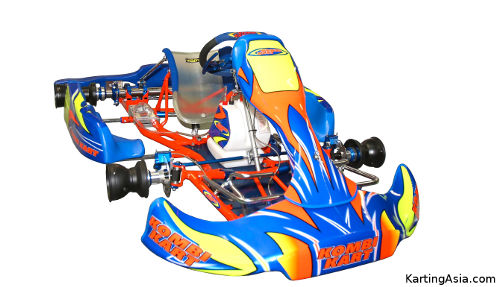Kombikart is the only Dutch manufacturer of CIK-FIA homologated race karts, operating out of a 3000m2 factory in Schijndel, Holland. With only 10 permament employees Kombikart is one of the smaller kart manufacturers, but they have still achieved a lot of success particularly in Rotax Max racing (Euro Challenge and National Championships). Their factory racing effort (Hugo Motorsports) is run by team manager Hugo van der Ham, a former Dutch kart-champion and formula car driver.
The KombiKart Challenge MKIII is the company’s only kart homologated for the 2009-2014 homologation period, and some of its unique design features ensure that despite having only one kart, it is capable of handling various different kinds of tyres and engines.The kart has two torsion bars in the front, one at the very back, and one just behind the seat (The “standard” among kart manufacturers is to have 1 on the front and one in the rear, and possibly an additional side torsion bar).
The kart should be especially suited to Rotax Max and similar categories given Kombikart’s success in Rotax racing, but their performance in KF and shifter kart (KZ) races shows that it should be equally capable there. We talked to Ton van de Burgt of Kombikart about the new chassis. He also reveales that looking at the competition is an important part of the design process.
Question: The Kombikart Challenge MKIII kart is your only kart for the 2009-2014 homologation period, what led to the final design of the kart?
Ton van de Burgt: Yes we homologated one model chassis for all categories. The MK3. We did a lot of testing in 2008 of course in the Rotax, KF, and KZ classes. With all this information from these tests we came up with this new model MK3. This chassis is an improvement over our former one of 2008 (The MK2) which already had a lot of success.
Q: Are there any specific new and/or interesting features on the kart that are different to most of the competition?
Ton: Yes we have 4 stabilizing bars in our new chassis; 2 in the front and 1 behind the seat and one on the rear, this because of the many types of tires that are used into the several classes so you can easily adjust the level of grip provided by the chassis.
Q: How do you approach the design of a new kart? Do you keep a very close eye on what the competition has been doing and try some of their solutions or do you prefer to focus only on your own kart and develop the kart by how if performs on track?
Ton: First we rely on our 25 years or experience in building chassis, and also we have computer programs that helps us design the chassis. Of course we also look at the competition and learn some things from them.
For example this new marrenello chassis with this special front end! We tested a similar solution already 8 years ago, but this system was then not working properly in all weather situations and was not approved by CIK.
Q: How important is a good driver to develop a kart? Who was the main driver(s) responsible for the direction the MKIII kart has taken?
Ton: Yes very important ! you need to have drivers that feel every change we make to the chassis and who is constantly every lap.
In 2008 we tested al with Mike Joossens in the seniors/ KF and Kay van Kemenade in the Juniors, also Frank van de Wind thit a lot of testing in the KZ.
Q: What will the factory racing (Team Hugo Motorsports) effort focus on in 2009, which series’? Will there still be a very strong focus on Rotax Max racing? Will there be a lot of focus on KF-categories?
Ton: The most important will be the Rotax National / Belgium / Euro challenge because it’s simple there is the most competition. KF has still not grown enough because of the higher cost. We will also compete in the National KZ and WSK
Q: Is there anything that you would like to see changed in the CIK-FIA chassis homologation regulations/procedures? (For example would you prefer longer or shorter homologation periods, would you prefer a smaller amount of required chassis for homologation than the current 75?)
Ton: Well 75 is a lot for us because we are a small manufacturer, but we are able to manage this. For the rest we do not have any complaints: there are a lot of tolerances into the regulations so we can always change some little things when necessary.
Q: KombiKart’s previous homologated kart was for the 2003-2008 period, while no karts were homologated for the 2006-2011 period. Do you feel that there is no need to homologate a new chassis every 3 years if the current kart is performing, or is it more of a budget issue?
Ton: If you homologated a chassis that is not performing well, then it’s a good thing that you can change after 3 years. But I never heard from manufacturers that this has happened, and as I mentioned above there are a lot of changes possible into the regulations.
Q: What is KombiKart’s most valued result in kart racing?
Ton: We have a lot, we have been the Dutch National Champion in Rotax Max for 7 Years, that is with a competitive field of 150 drivers in out National Rotax Max Challenge. We also achieved the European Rotax Max title in 2006 and 2007 plus the European constructors title in 2007.
Pictures:
More:
- Discuss this article in the forums in THIS THREAD.
- KombiKart Official Website
